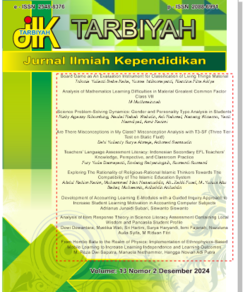Analysis of Mathematics Learning Difficulties in Material Greatest Common Factor Class VII
DOI:
https://doi.org/10.18592/tarbiyah.v13i2.12733Keywords:
Analysis of Mathematics, difficulty learning, greatest common factorAbstract
In Class VII, some students still need help finding the most significant common factor of several numbers. This research aims to describe the difficulties experienced by students in finding the Greatest Common Factor (FPB) of several numbers. The subject of this research was 1 class VII student of SMPII Lukman Al-Hakim 02 Batam. The object of this research is the difficulty of learning mathematics in the Greatest Common Factor (FPB) material. The data collection technique in this research was conducting interviews, giving test questions, and documenting 1 class VII female student. Based on the interview results, it was clear that the student needed help working on the questions and understanding the FPB material. Apart from that, the test result showed that students were both in ordinary questions and stories; students are less able to do them, so they need repetition and learning to be done so that their understanding of the mathematics of the FPB material can be understood well. The difficulties were: (1) Students needed to correct their carrying out division calculation operations in FPB questions; (2) Students needed help concluding the final answers to FPB questions. This research implies that mathematics teachers must emphasize instilling the concept of FPB material, ensuring that students have mastered division arithmetic operations in solving FPB problems.References
Ahmadi, A., & Supriyono, W. (2013). Psikologi Belajar. Jakarta: PT. Rineka Cipta.
'Alimah, N. U., Winarni, E. W., & Supriatna, I. (2022). Studi Deskriptif Kesulitan Belajar Matematika Materi KPK dan FPB Serta Penanganannya pada Siswa Kelas IV. JuRiDikDas: Jurnal Riset Pendidikan Dasar, 5(3), 408-416.
Amalia, N., & Unaenah, E. (2018). Analisis Kesulitan Belajar Matematika pada Siswa Kelas III Sekolah Dasar. Attadib: Journal of Elementary Education, 3(2), 123-133.
Asmawati, L., Husniati, & Khair, B. N. (2023). Identifikasi Kesulitan Belajar Matematika Siswa Kelas IV Pada Materi KPK dan FPB di SDN 03 Suka Makmur Kecamatan Gerung. Jurnal Ilmiah Widya Pustaka Pendidikan, 11(2), 8-16.
Aunurrahman. (2010). Belajar dan Pembelajaran. Bandung: Alfabeta.
Depdiknas. (2001). Kurikulum Berbasis Kompetensi Mata Pelajaran Matematika Sekolah Dasar. Jakarta: Depdiknas.
Dimyati, & Mudjiono. (2015). Belajar dan Pembelajaran. Jakarta: Rineka Cipta .
Djamarah. (2015). Psikologi Belajar. Jakarta: PT. Rineka Cipta.
Fariana, A. N., Nahli, N. M., Herdiawal, Fuadi, A., & Nurjannah. (2022). Diagnostik Kesulitan Belajar Matematika Siswa Pada Materi FPB & KPK Kelas V SD Negeri. Jurnal Pendidikan Dasar dan Keguruan, 7(2), 1-7.
Iskandar, S. (2008). Materi Mata Kuliah Belajar dan Pembelajaran. Sumbawa: Universitas Samawa.
Jamaris, M. (2015). Kesulitan Belajar Perspektif Asesmen dan Penanggulangannya. Bogor: Ghalia Indonesia.
Kholil, M. (2020). Faktor-faktor Kesulitan Belajar Matematika Siswa Madrasah Ibtidaiyah Da'watul Falah Kecamatan Tegaldlimo Kabupaten Banyuwangi. Educare: Journal of Primary Education, 1(2), 151-168.
Mahmud, M. R., & dkk. (2023). Learning Obstacles Analysis of Lowest Common Multiple and Greatest Common Factor in Primary School. Jurnal Elemen, 9(2), 440-449.
Mokalu, V. R., & dkk. (2022). Hubungan Teori Belajar dengan Teknologi Pendidikan. Edukatif: Jurnal Ilmu Pendidikan, 4(1), 1475-1486.
Mulyono, A. (2013). Anak Berkesulitan Belajar. Jakarta: PT. Rineka Cipta.
Muthma'innah, M. (2023). Analysis of Students' Mastery of Mathematical Concepts Material for Linear Equations in Two Variables. Tarbiyah: Jurnal Ilmiah Kependidikan, 12(2), 135-147.
Muthma'innah, M. (2023). Difficulty Learning Mathematics Material for Multiplication Counting Operations in Elementary School. Rangkiang Mathematics Journal, 29-33.
Muthma'innah, M. (2023). Urgensi Pemikiran Filsafat dalam Meningkatkan Mutu Pendidikan Matematika. Lattice Journal: Journal of Mathematics Education and Applied, 3(2), 157-169.
Nabilah, Unaenah, E., Lestari, L., & Nurvitasari. (2022). Analisis Kesulitan Pembelajaran FPB dan KPK di Kelas 5 SDN Kampung Besar 2 Teluknaga. MASALIQ: Jurnal Pendidikan dan Sains, 2(4), 505-512.
Rohayani, A. Y. (2022). Didactical Design to Complete the Story Questions on FPB in Elementary School. International Conference on Elementary Education (ICEE-2), 2(1), 1688-1693.
Sintika, U. D., Wardana, M. Y., & Subekti, E. E. (2021). Analisis Kesulitan Belajar Siswa Ditinjau Dari Kemampuan Pemecahan Masalah Matematika Materi FPB dan KPK Kelas IV SD Negeri Karangtempal. Dwijaloka: Jurnal Pendidikan Dasar dan Menengah, 2(4), 494-499.
Slameto. (2013). Belajar dan Faktor-faktor yang Mempengaruhinya. Jakarta: Rineka Cipta.
Subarinah, S. (2006). Inovasi Pembelajaran Matematika SD. Jakarta: Depdiknas.
Sugiyono. (2016). Metode Penelitian Kuantitatif, Kualitatif dan R&D. Bandung : PT Alfabet.
Susilawati, W. (2020). Belajar dan Pembelajaran Matematika. Yogyakarta: CV Insan Mandiri.
Triwiyanto, T. (2014). Pengantar Pendidikan. Jakarta: Bumi Aksara.
Unaenah, E., & dkk. (2020). Analisis Pembelajaran FPB dan KPK dengan Model Pohon Faktor dan Tabel Kelas IV Sekolah Dasar. PENSA: Jurnal Pendidikan dan Ilmu Sosial, 2(1), 75-86.
Unaenah, E., Anggita, A. D., Nusaibah, F., & Gunawan, F. A. (2023). Analisis Kesulitan Belajar Matematika Materi FPB dan KPK Siswa Kelas IV. Jurnal Pendidikan: SEROJA, 2(3), 1-19.
Utami, G., Saputro, B. A., & Untari, M. F. (2020). Error Analysis In Solving Fpb And KPK Story Questions Based On Polya Procedures For Fourth Grade Elementary School Students. Jurnal Ilmiah Sekolah Dasar, 4(4), 642-654.
Wardana, & Djamaluddin, A. (2021). Belajar dan Pembelajaran. Sulawesi Selatan: CV Kaaffah Learning Center.
Downloads
Published
How to Cite
Issue
Section
License
Copyright (c) 2024 M Muthmainnah

This work is licensed under a Creative Commons Attribution 4.0 International License.
Authors retain copyright and grant the journal right of first publication with the work simultaneously licensed under a Creative Commons Attribution 4.0 International License that allows others to share the work with an acknowledgment of the work's authorship and initial publication in this journal.




